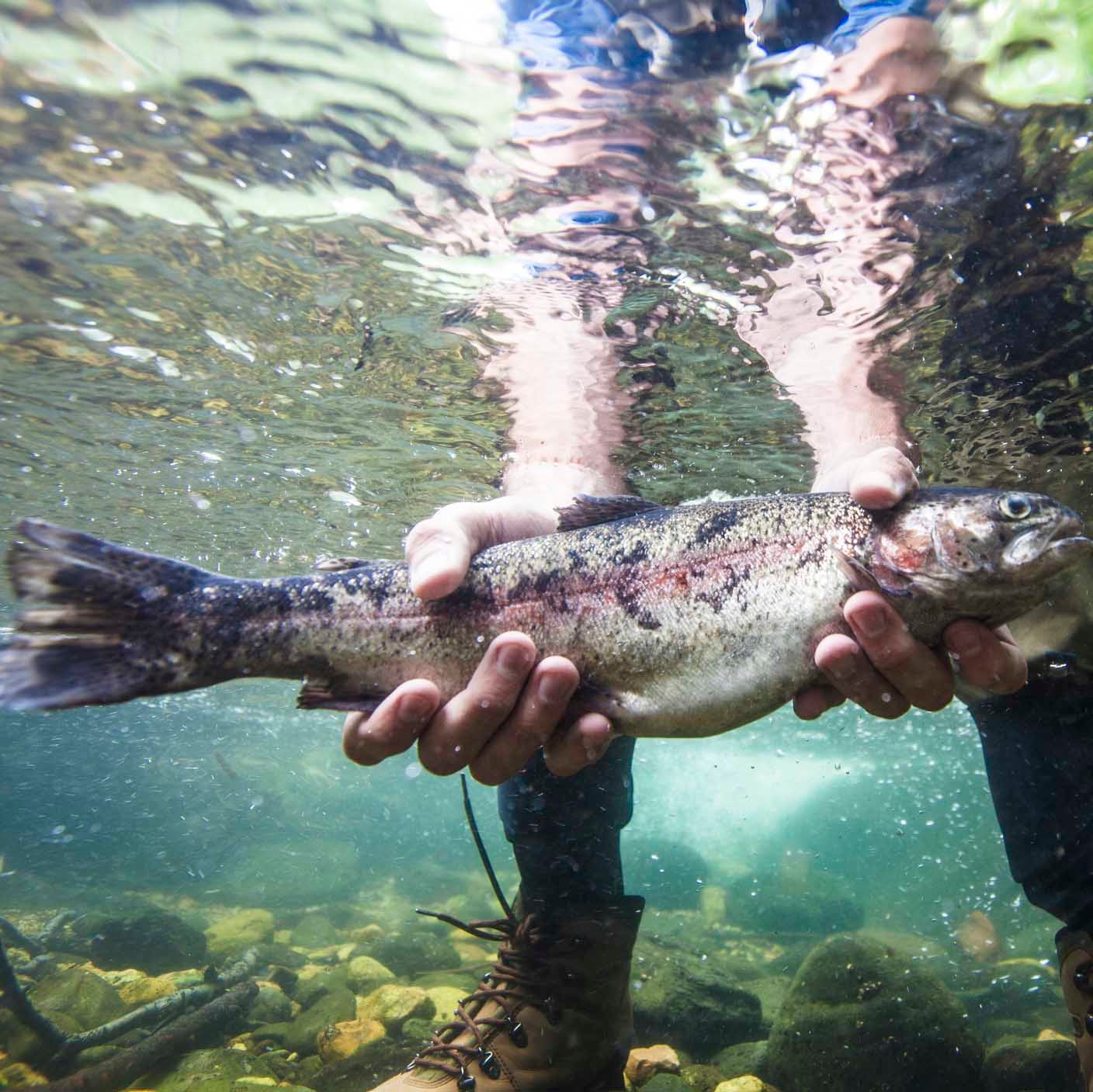The not-so-small acts of kindness stuck out to Luke Konson and Daniel Balserak. Local anglers shared priceless intel about how to catch their stateтАЩs official fish and, Konson says, тАЬGot us onto spots we had no business being.тАЭ
In Hawaii, a family let the two borrow their minivan to get around the island, and a sailor offered the teenage boys a place to stay. Trying to catch channel catfish in Iowa, they pulled into a Raising CaneтАЩs restaurant for directions and met a man who recognized them from a story in a local paper. HeтАЩd read about their mission to catch the state fish in every U.S. state. He wished them luck, then handed them $200.
A fishing guide in Alaska donated time and resources. A governor honored them at the state capitol. Once, they were stuck on a snowy pass in New Mexico, without cell service and 20 miles from the nearest town, when a guy in a four-wheel-drive Jeep reversed back up the mountain and towed them to safety. And during one of their lowest moments, stranded at an auto repair shop in North Carolina with a wrecked van, a stranger booked them a hotel room. All this because theyтАЩd set out to catch some fish.
Luke Konson grew up fishing with his dad, Mickey, at a neighborhood pond in Fairfax, Virginia, a suburb of Washington, D.C. As a teenager, he began migrating to more unique and adventurous fishing locations.
The COVID-19 pandemic hit during the spring of LukeтАЩs senior year in high school. He was heading to Clemson University in the fall of 2020, but the college delayed the semester five weeks and then moved classes online. So Luke and his dad got to thinking: what else might he do? To their knowledge, no one had ever tried to catch the state fish in every U.S. stateтАФsort of like birdingтАЩs Big Year challenge but for fish.
Nearly every state government has officially named at least one state fishтАФsave Iowa and Ohio, where the state fish designation remains unofficial. Many coastal states claim two state fish, one for saltwater and one for freshwater. In conceptualizing his quest, Konson decided he would try to catch either the saltwater or freshwater fish within every stateтАЩs borders.
He dubbed the quest Fish All Fifty and ran the idea by his buddy Daniel Balserak, whoтАЩd also enrolled at Clemson. Balserak, who had similarly been taught to fish by his father at age four, managed to convince his own parents to let him go. In August 2020, the two 18-year-olds loaded up the Konson family minivan and prepared to set out.
They divided the project into four different trips. The first leg covered the NortheastтАФa circular route up to Maine, over to western Pennsylvania, down to West Virginia, and then back home. On their second outing, they fished 20 states in the Midwest and Southeast, venturing up to Minnesota, down to Texas, and over to Florida. But they caught the wrong fish in AlabamaтАФthe Alabama bass, not the largemouthтАФso in January 2021 they headed back through the South and toward the Rockies. Historic winter lows made the fishing harder, so they retreated before making it to the Southwest. In April, they set out again, starting in New Mexico and the Four Corners, making their way to California, up the West Coast, and back over to the Dakotas.
Each outing taught them something new. In their first state, Maryland, Konson and Balserak spent three days fishing for striped bass before finally catching two thumb-sized specimens. тАЬWow, this is going to be really tough if every state takes this long,тАЭ Konson recalls saying. Seven different states along the East Coast have recognized the striped bass as the official saltwater fish.
Turns out, Konson says, тАЬEvery state took way longer.тАЭ
Early in the project, Konson and Balserak discovered that each stateтАЩs fish also told a story about its people, past and present. Following their struggles in Maryland, they headed to Rhode Island, where a tackle shop employee clued them in on the trick to catching stripers: fish the high tide at night from a bridge. They set their alarms for 3 A.M. When they climbed out of the van, where they usually slept in the front seats, the duo found the spot packed with anglers. тАЬSeeing what each fish meant to the people in that state, it made each one a little bit special,тАЭ Konson says.
In the West, especially, the naming of the state fish often serves a conservation purpose. тАЬThose states were learning processes for us,тАЭ Balserak says. In New Mexico, they hiked more than 80 miles, desperately searching for the Rio Grande cutthroat. Finally, a kindly fly shop in Taos mapped out a canтАЩt-miss spot. тАЬWhen you put in the work and catch a fish that colorful, thereтАЩs no better feeling,тАЭ Konson says. Fishing in the West, they came to understand how generations of Indigenous peoples had subsisted predominantly on fish like trout and salmon. And how our modern meddlingтАФthrough the stocking of non-native species, land development, and climate changeтАФhas hurt native fish populations. According to Trout Unlimited, of the 28 native trout species and subspecies in the United States, three are extinct and six are listed as threatened or endangered. Ninety two percent of all native trout face some level of risk.
Less revered fish face challenges, too. In Arkansas, Konson and Balserak spent more than three weeks trying to catch an alligator gar in the Arkansas River. They even fished with Mark Spitzer, the expert angler and author who helped River Monsters TV series host Jeremy Wade catch oneтАФbut no luck. Spitzer eventually told them, тАЬHonestly, your chances of catching two alligator gar in Arkansas are very low.тАЭ The prehistoric fish, which can weigh up to 300 pounds, has been decimated by bowfishing (and other causes) in its recognized state of Arkansas.
Finally, Konson and Balserak conceded and headed to the Trinity River in Texas, where they each caught an alligator gar. тАЬThere was something that felt almost wrong about taking those out of the water,тАЭ Balserak says. With its hardened scales and protruding teeth, Konson says, the fish тАЬdonтАЩt even look like animals.тАЭ ButтАжdid they fudge that fish? Technically, Konson says, the alligator gar is ArkansasтАЩs primitive state fish, not the official state fish. тАЬIt was a bit of loophole,тАЭ he admits.
Arkansas governor Asa Hutchinson still honored their efforts. He invited the two to the capitol and gave them a signed document acknowledging them as official state travelers. Hutchinson had previously bestowed a similar honor on a ten-year-old boy named Henry Foster. In 2018, Foster wrote the Arkansas state legislature and started a Change.org petition requesting lawmakers help protect alligator gar with recognition from the state government. In 2019, Hutchinson signed the designation into law, with Foster in attendance.
Bearing witness to the negative human impact on fish species across the United StatesтАФand our ability to right some of those wrongsтАФaffected both Konson and Balserak. When Konson enrolled at Clemson in the fall of 2021, he chose wildlife and fisheries biology as his major.
Of course, state governments vote on more than feel-good bills about state fish. Around the time the two visited with Governor Hutchinson, in the spring of 2021, the Arkansas legislature was drafting bills that limited transgender participation in youth sports and access to gender-affirming care. (Hutchinson signed the anti-trans youth sports bill but vetoed the gender-affirming care bill, calling it тАЬtoo extreme.тАЭ The Arkansas legislature overrode his veto.)
The legislation, which became a national flashpoint on transgender rights, was just one of many politically and culturally fraught issues Konson and Balserak found themselves physically passing through as they traveled around the country trying to catch fish. In August 2020, in a New York City quieted by COVID-19 restrictions, they donned cloth masks and posed with their fishing rods in an eerily empty Times Square. тАЬThat was sobering,тАЭ Balserak says. Sure, they were on an adventure, but much of the country was just trying to survive.
Driving across the United States, subsisting on Slim Jims and bulk bags of cereal, the teenagers became accustomed to encounters with law enforcement. On the nights when they couldnтАЩt find a Walmart parking lot to sleep in, they often got тАЬthe knockтАЭ well-known to #vanlifersтАФwaking up to a cop peering through the window at their mess of tackle and telling them to move along. Once, at 3 A.M., two officers asked Konson and Balserak (who are both white) to get out of the van and spoke to them separately. Balserak says, тАЬWe didnтАЩt have anything to hide. I was just scared Luke was going to say something that wasnтАЩt compatible.тАЭ
тАЬWe had like eight fishing rods inside our van,тАЭ Konson says. тАЬIt was pretty clear we were telling the truth or just had a very elaborate cover-up.тАЭ
A couple officers ended up following them on social media @fishallfifty.
Everywhere they went, people seemed to connect with their story and often helped the duo get to their next state to catch their next fish. тАЬSeeing all this conflict, but through all of it, there were so many people willing to help and do what they can,тАЭ Konson says.
Three states remained as Fish All Fifty came to its conclusion in late 2021. The app FishBrain (like Strava but for fishing) helped fund their travel to Hawaii. One of their online followers pointed them to a marina in downtown Honolulu, where they caught the reef triggerfishтАФin Hawaiian, the humuhumunukunukuapuaa. Then, with support from another app, Alaska FishTopia, Konson and Balserak flew from Hawaii to Anchorage. Their dads met them there. The fathers and sons traveled to the Kenai River, one of the countryтАЩs most revered fisheries. Using barbless hooks, they cast for the heavily protected king salmon, leaving the fish safely in the water while photographing their catch.
They saved their home state of Virginia for last. In the fall of 2021, days before heading off to school for their freshman semester at Clemson, Konson and Balserak drove up into the Shenandoah Mountains. There, they caught their final fish: two small but colorful brook trout. They put the young fish back into the churning water and let them swim away.


